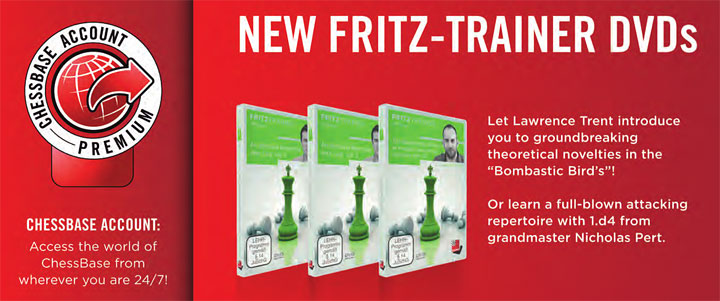Ben Johnson’s superb ‘Perpetual Chess Podcast’ includes a variety of advice on how to improve, and given the range of interviewees, this advice is often contradictory:
i. Focus on endings – this will have the biggest impact on your results, as you will convert promising positions and save worse ones.
ii. Focus on tactics – you will find opportunities throughout the game that your opponents will miss.
iii. Focus on openings – computers make it easy for your opponent to out prepare you, and extensive knowledge in a range of lines will enable you to spring traps of your own.
I am an adherent of the third option, not because I think it's the best way to improve my chess, but because I enjoy it. IM Kaare Kristensen describes enjoyment as the tenet of chess improvement, which is advice I think we can all appreciate.
Preparation for a game can reap benefits at all levels, and over the last few months I have come to believe in the value of surprise. If you play the same variation of the Sicilian Dragon week in, week out, your opponent has a clear target. Conversely, whilst springing surprises can undermine an opponent’s prep, and give a psychological advantage, it will be for naught if you don’t understand the resultant positions. With this in mind, I wanted to explore different types of opening surprise, and summarise the advantages and pitfalls of each.
The Theoretical Novelty
There are two types of opening preparation that are guaranteed to surprise your opponent. The first, and most dramatic approach, is to play a move that you know they won’t have seen before, such as:
| Replay and check the LiveBook here |
Please, wait...
1.d4 f5 2.Na3!? Nf6 3.Nf3 e6 3...d5 4.Bf4 c6 4...e6 5.Nb5 Na6 6.e3 c6 7.Nc3 7.-- 5.e3 e6 6.c3 6.c4 Bb4+ 4.Nc4 d6 4...d5 5.Nce5 5.Bf4 - Start an analysis engine:
- Try maximizing the board:
- Use the four cursor keys to replay the game. Make moves to analyse yourself.
- Press Ctrl-B to rotate the board.
- Drag the split bars between window panes.
- Download&Clip PGN/GIF/FEN/QR Codes. Share the game.
- Games viewed here will automatically be stored in your cloud clipboard (if you are logged in). Use the cloud clipboard also in ChessBase.
- Create an account to access the games cloud.
The personal novelty
| Replay and check the LiveBook here |
Please, wait...
1.e4 c5 2.Nf3 g6 3.c3 3.d4 cxd4 4.Qxd4 4.Nxd4 Nc6 5.c4 Nf6 6.Nc3 d6 4...Nf6 5.e5 Nc6 6.Qa4 Nd5 7.Qe4 Ndb4 3...Bg7 3...d5 4.d4 cxd4 5.cxd4 d5 6.e5 Nc6 7.Bb5 Bg4 8.Bxc6+ bxc6 9.Nbd2 e6 10.h3 Bxf3 11.Nxf3 Ne7 11...c5 12.dxc5 Qa5+ 13.Bd2 Qxc5 14.Qa4+ 12.0-0 0-0 13.Re1 Rb8 14.b3 Qa5 15.Qd2 15...Qa6 16.Qe2 Qa5 17.Bd2 Qa3 18.Bc1 Qa5 19.Bg5 Rfe8 20.Rec1 Qb6 21.Rc5 Nf5 22.Rac1 22...h6? 22...Bf8 23.Rxc6 Nxd4 24.Nxd4 Qxd4 25.Rc7 Bg7 26.Qf3 Rf8 23.Bd2 Bf8 24.Ba5! Bxc5 25.Bxb6 Bxb6 26.Qd2 Kg7 27.Rxc6 Rec8 28.Rxc8 Rxc8 29.g4 Ne7 30.h4 Nc6 31.b4 a5 32.a3 axb4 33.axb4 Ra8 34.b5 Ra1+ 35.Kg2 Na5 36.h5 Nc4 37.Qf4 gxh5 38.Qf6+ Kg8 39.g5 hxg5 40.Nxg5 Ra7 41.Nf3 Na3 42.Qg5+ Kf8 43.Qh6+ Ke8 44.Qh8+ Ke7 45.Qf6+ Ke8 46.Qh8+ Ke7 47.Qb8 Nc4 48.Nd2 Bxd4 49.Nxc4 dxc4 50.Qd6+ 1–0 - Start an analysis engine:
- Try maximizing the board:
- Use the four cursor keys to replay the game. Make moves to analyse yourself.
- Press Ctrl-B to rotate the board.
- Drag the split bars between window panes.
- Download&Clip PGN/GIF/FEN/QR Codes. Share the game.
- Games viewed here will automatically be stored in your cloud clipboard (if you are logged in). Use the cloud clipboard also in ChessBase.
- Create an account to access the games cloud.
| Cumming,R | - | Lunn,M | - | 1–0 | 2020 | B27 | Martlets Cup | |
Please, wait...
I think this kind of surprise can work well, but only if you’re comfortable in a range of positions. With this in mind, there is a more pragmatic approach to opening surprises...
The Personal Finesse
The personal finesse involves sticking to your basic repertoire – which your opponent has likely prepared for – but to play an early finesse. This is the easiest to learn in the hours before a game, and the option with the least risk, as you are likely to have a base knowledge of the lines.
| Replay and check the LiveBook here |
Please, wait...
1.d4 Nf6 2.c4 e6 3.Nc3 Bb4 4.Qc2 0-0 5.e4 d5 6.e5 Ne4 7.Bd3 c5 8.Nf3 8.cxd5 exd5 9.Nge2 cxd4 10.Nxd4 Nd7 11.f4 Qh4+ 12.g3 Qh3 13.Bf1 Qh6 14.Bg2 Qa6 15.Nde2 Qb6 16.Bxe4 dxe4 17.a3 Nc5 18.Be3 Nd3+ 19.Qxd3 exd3 20.Bxb6 axb6 8...cxd4 9.Nxd4 Nd7 10.Bf4 Ndc5 10...Qh4 11.0-0 Bxc3 12.bxc3 Bd7 13.Be2 Na4 14.cxd5 exd5 15.c4 Rc8 16.Rac1 Nac3 17.Qb2 Qa5 18.cxd5? 18.Qxb7 Rfd8 18...Bc6 19.Qb2 Rb8 20.Qc2 Ba4 21.Qd3 dxc4 22.Qe3 19.Qb2 18...Nxd5? 18...Qxd5 19.Be3 19.Nf3? Nxe2+ 20.Qxe2 Bb5 19...Qxe5 20.Qxb7 Rc7 21.Qb2 Rfc8 19.Bg3 19.Qxb7 Nec3 19...Rb8 20.Qxd7 Nxf4 21.Qf5! Nxe2+ 22.Nxe2 20.Bg3 Qa4 21.Bd1! Qxd4 22.Qxd7 Rfd8 23.Qg4 Qd2 24.Ra1 19...Nxg3 19...Ndc3 20.Bf4 Qd5 21.Be3 Qxe5 22.Qxb7 Rfd8 20.hxg3 Nb6 21.Nb3 21.f4 21...Qb4 22.Rxc8 22.Qd4 Qxd4 22...Qe7 23.Nc5 Bc6 24.Ne4 Rcd8 25.Nd6 f6 26.f4 23.Nxd4 22...Rxc8 23.Rc1 Rxc1+ 24.Qxc1 Bc6 25.Qd2 25.Bf3 Nc4 25...Bxf3 26.gxf3 Nc4 27.Qg5 h6 28.Qd8+ Kh7 29.Qd3+ Kg8 30.f4 25...g6 26.Bxc6 bxc6 27.Nc5 Qd4 28.e6 Nd5 26.Bxc6 bxc6 27.Qg5 Qe1+ 28.Kh2 Qd1 29.Qe7 Qh5+ 30.Kg1 Qd1+ 31.Kh2 Qh5+ 32.Kg1 Qd1+ 33.Kh2 25...Qxd2 26.Nxd2 Bd5 26...Nd7 27.f4 f6 28.exf6 Nxf6 27.a3 Kf8 28.f4 Ke7 29.Kf2 f6 30.exf6+ Kxf6 31.g4 h6 ½–½ - Start an analysis engine:
- Try maximizing the board:
- Use the four cursor keys to replay the game. Make moves to analyse yourself.
- Press Ctrl-B to rotate the board.
- Drag the split bars between window panes.
- Download&Clip PGN/GIF/FEN/QR Codes. Share the game.
- Games viewed here will automatically be stored in your cloud clipboard (if you are logged in). Use the cloud clipboard also in ChessBase.
- Create an account to access the games cloud.
| Lunn,M | - | Brewer,C | - | ½–½ | 2020 | E32 | Martlets Cup | |
Please, wait...
 About the author
About the author
Matthew Lunn is a contributor to CHESS magazine, where he reflects on the mistakes that he makes, and attempts to learn from them. He lives in London and works in the transport sector.
Also read:
Matthew Lunn: Dealing with the Englund
ChessBase products from Chess & Bridge

Order online at shop.chess.co.uk or Chess4Less in the US




 About the author
About the author